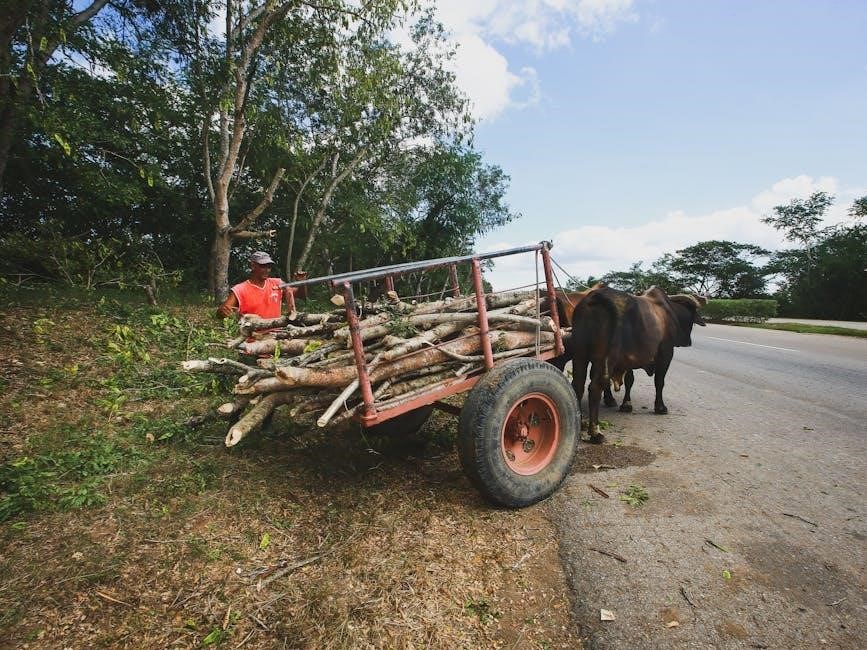What is a Manual Dump Trailer?
A manual dump trailer is a specialized utility trailer designed for hauling and unloading heavy materials. It features a tilting bed mechanism‚ allowing cargo to be dumped efficiently without manual lifting. Ideal for construction‚ landscaping‚ and agricultural tasks‚ it offers a cost-effective alternative to larger commercial vehicles‚ combining durability and versatility for various projects.
1.1 Definition and Explanation
A manual dump trailer is a specialized utility trailer equipped with a tilting bed mechanism‚ allowing for easy unloading of heavy materials like debris or construction supplies. Designed for efficiency‚ it combines manual or hydraulic lifting systems with a durable build‚ making it ideal for construction‚ landscaping‚ and agricultural tasks while offering cost-effective versatility.
1.2 Key Features and Mechanisms
Manual dump trailers feature a tilting bed‚ often operated by hydraulic or manual mechanisms‚ enabling easy unloading of materials. They include sturdy axles‚ durable construction materials‚ and varying gate types for customized loading/unloading needs. These trailers are designed for efficiency‚ safety‚ and versatility‚ catering to both small-scale and heavy-duty applications effectively.
Uses and Benefits of a Manual Dump Trailer
Manual dump trailers are ideal for construction‚ landscaping‚ and agriculture‚ offering efficient material transport and unloading. They provide cost-effective solutions for heavy-duty tasks‚ enhancing productivity and versatility in various projects.
2.1 Common Applications in Construction and Landscaping
Manual dump trailers are widely used in construction for transporting materials like gravel‚ sand‚ and debris. In landscaping‚ they efficiently haul dirt‚ mulch‚ and plants. Their versatility and ease of unloading make them essential for site preparation‚ excavation‚ and outdoor projects‚ ensuring efficient material handling and workflow optimization.
2.2 Advantages Over Traditional Dump Trucks
Manual dump trailers offer cost-effectiveness‚ portability‚ and ease of use compared to traditional dump trucks. They require less investment‚ are more maneuverable in tight spaces‚ and are ideal for smaller-scale projects. Their compact size also reduces weight and enhances fuel efficiency‚ making them a practical choice for construction and landscaping tasks.
2.3 Cost-Effectiveness and Efficiency
Manual dump trailers are a cost-effective solution for handling materials like gravel or debris. They reduce operational costs‚ require lower investment‚ and are efficient for smaller-scale projects. Their compact design allows for easy maneuverability‚ making them ideal for tasks that don’t demand large machinery‚ thus minimizing manual labor and optimizing workflow.

Types of Manual Dump Trailers
Manual dump trailers vary by size‚ capacity‚ and construction materials. They range from compact models for small tasks to heavy-duty designs for industrial use‚ offering versatility and durability.
3.1 Size and Capacity Options
Manual dump trailers come in various sizes‚ ranging from 8 to 30 feet in length and 5 to 8.5 feet in width. Capacities vary‚ with common models like 5×8‚ 6×10‚ or 7×14 feet‚ offering flexibility for different loads. The size and capacity are chosen based on the intended use‚ ensuring efficiency and maneuverability for specific tasks.
3.2 Material and Construction Variations
Manual dump trailers are constructed from durable materials like steel or aluminum‚ offering varying levels of strength and weight. Steel models are heavier but more robust‚ while aluminum options are lighter and corrosion-resistant. The trailer’s width typically ranges from 5 to 8.5 feet‚ adhering to road limits‚ ensuring versatility for different payloads and applications.
3.3 Gate and Lifting Mechanisms
Manual dump trailers feature varying gate types‚ such as swing gates or fold-down designs‚ to facilitate easy unloading. Lifting mechanisms‚ often hydraulic or mechanical‚ enable efficient tilting of the trailer bed. These components are designed to withstand heavy loads‚ ensuring smooth operation and minimizing manual effort during material discharge.
Choosing the Right Manual Dump Trailer
Selecting the right manual dump trailer involves assessing your towing vehicle’s capacity‚ matching the trailer size to your workload‚ and ensuring proper axle configuration for safe operation.
4.1 Assessing Your Towing Vehicle’s Capacity
Assessing your towing vehicle’s capacity is crucial to ensure safe operation. Check your vehicle’s towing capacity in the owner’s manual or on the VIN sticker. Exceeding this limit can lead to loss of control‚ damage‚ or safety risks.
4.2 Matching Trailer Size to Work Requirements
Choosing the right trailer size depends on the type of work. Dump trailers range from 8ft to 30ft in length‚ with 14ft being common for heavy-duty tasks. Compact models (5x8ft) suit small jobs‚ while larger ones (7x14ft) handle heavy loads. Ensure the trailer fits your workspace and load requirements for optimal efficiency and safety.
4.3 Importance of Axle Configuration
Axle configuration is crucial for manual dump trailers‚ affecting payload capacity‚ stability‚ and durability. Single‚ tandem‚ or triple axles are options‚ with tandem axles offering better weight distribution and traction. Proper axle setup ensures safe and efficient operation‚ preventing overloading and structural strain while matching the trailer’s intended use.
Safety Considerations
Safety is critical when operating a manual dump trailer. Always follow guidelines‚ secure loads properly‚ and wear protective gear to minimize hazards and ensure safe operation.
5.1 Loading and Unloading Precautions
Always load cargo within the trailer’s weight capacity and secure it properly to prevent shifting. Use ramps carefully and ensure the trailer is on level ground when unloading. Never exceed the recommended load limits‚ and follow the owner’s manual guidelines for safe operation to avoid accidents and damage.
5.2 Towing Safety Guidelines
Always ensure your towing vehicle’s capacity matches the trailer’s weight. Check that the receiver and ball mount are compatible and rated for the load. Secure the trailer with safety chains and ensure proper brake function. Never exceed towing limits‚ and maintain a safe distance while driving to prevent accidents.
5.3 Regular Maintenance Checks
Regularly inspect the trailer’s tires‚ brakes‚ and axle for wear. Check hydraulic systems for leaks and ensure proper fluid levels. Lubricate moving parts and examine the gate and lifting mechanisms for smooth operation. Addressing issues promptly helps prevent breakdowns and extends the trailer’s lifespan‚ ensuring safe and efficient performance.
Owner’s Manual and Instructions
The owner’s manual provides essential guidance for operating and maintaining a manual dump trailer. It includes safety protocols‚ loading limits‚ and step-by-step instructions for optimal performance and longevity.
6.1 Understanding the Manual’s Content
The manual provides detailed instructions for safe operation‚ maintenance‚ and troubleshooting; It includes technical specifications‚ warranty information‚ and guidelines for proper trailer usage. Reading the manual is crucial for understanding safety protocols‚ operational limits‚ and care tips to ensure longevity and efficiency of the manual dump trailer.
6.2 Essential Safety Information
The manual emphasizes critical safety measures‚ such as adhering to weight limits‚ securing cargo properly‚ and wearing personal protective equipment. It also outlines risks of overloading and improper towing‚ stressing the importance of following guidelines to prevent accidents and ensure safe operation of the manual dump trailer.
6.3 Operation and Maintenance Tips
Regular lubrication of moving parts and hydraulic systems is crucial for smooth operation. Inspect tires‚ brakes‚ and coupling systems before use. Clean the trailer bed after each job to prevent rust. Store the trailer on level ground and engage brakes when parked. Follow manufacturer guidelines for hydraulic fluid replacement and gate mechanism checks.
Budgeting and Financing Options
Budgeting for a manual dump trailer involves considering new or used models‚ with prices varying based on size and features. Financing options‚ like dealer plans‚ can help spread costs‚ while warranties provide added protection and peace of mind for your investment.
7.1 Pricing Range for New and Used Models
New manual dump trailers typically range from $3‚000 to $15‚000‚ depending on size and features. Used models are more affordable‚ starting at $2‚000‚ offering cost savings for those with budget constraints. Prices vary based on brand‚ capacity‚ and condition‚ making it essential to compare options for the best value.
7.2 Warranty and Support Considerations
Warranty and support are crucial when purchasing a manual dump trailer. Look for manufacturers offering comprehensive warranties that cover repairs and replacements for parts and labor. Reliable customer support ensures assistance with maintenance and troubleshooting. Understanding warranty terms and support options helps protect your investment and ensures long-term satisfaction and protection.
7.3 Financing Plans for Purchasing
Financing plans for manual dump trailers offer flexible options to spread costs. Many dealers provide loans or payment plans tailored to your budget. These plans allow you to purchase the trailer without upfront payment‚ making it more accessible for individuals and businesses. Review terms carefully to ensure affordability and suitability for your financial situation.

Towing Capacity and Vehicle Compatibility
Ensure your tow vehicle’s capacity matches the manual dump trailer’s weight. Exceeding limits risks loss of control‚ accidents‚ or damage. Always check and match receiver and ball mount ratings for safe towing.
8.1 Understanding Towing Limits
Understanding towing limits is crucial for safe operation. Your vehicle’s towing capacity‚ as specified by the manufacturer‚ must exceed the loaded weight of the manual dump trailer. Exceeding these limits can lead to loss of control‚ accidents‚ or damage to both the trailer and towing vehicle. Always consult your vehicle’s specifications to ensure compatibility and safety.
8.2 Matching Receiver and Ball Mount
Properly matching the receiver and ball mount is essential for safe towing. The receiver hitch and ball mount must align with the trailer’s coupling system and be rated for the trailer’s weight. Correct configuration ensures even weight distribution‚ prevents sway‚ and maintains control while towing‚ enhancing overall safety and stability on the road.
8.3 Avoiding Overloading Risks
Overloading a manual dump trailer can lead to structural damage‚ tire failure‚ and loss of control. Always adhere to the trailer’s weight capacity specified in the owner’s manual. Distribute the load evenly and avoid exceeding the gross vehicle weight rating (GVWR). Regularly check axles and tires to ensure they can handle the load safely.

Maintenance and Repair Tips
Regular lubrication of moving parts and checking tire pressure ensures optimal performance. Inspect hydraulic systems for leaks and maintain proper fluid levels to prevent mechanical failures.
9.1 Regular Maintenance Schedule
A regular maintenance schedule for a manual dump trailer includes monthly inspections of the hydraulic system‚ lubrication of hinges and axles‚ and checking tire pressure. Quarterly‚ inspect the wiring and brakes‚ and annually‚ service the hydraulic pump and replace seals as needed to ensure longevity and safety.
9.2 Common Issues and Solutions
Common issues with manual dump trailers include hydraulic leaks‚ faulty gate mechanisms‚ and worn-out tires. Solutions involve replacing damaged hydraulic hoses‚ adjusting or replacing gate components‚ and rotating or replacing tires. Regular inspections can prevent these issues‚ ensuring smooth operation and extending the trailer’s lifespan.
9.3 Extending Trailer Lifespan
To extend the lifespan of your manual dump trailer‚ perform regular maintenance checks‚ including lubricating moving parts and inspecting for wear. Protect against rust with a durable coating and store the trailer in a dry‚ shaded area when not in use. This will ensure optimal performance and longevity.

Legal and Regulatory Compliance
Ensure your manual dump trailer meets local‚ state‚ and federal regulations‚ including size restrictions‚ towing laws‚ and safety standards. Verify insurance and licensing requirements to avoid penalties.
10.1 Trailer Width and Road Limits
Manual dump trailers typically range from 5 to 8.5 feet in width‚ with compact models starting at 60 inches and heavy-duty versions reaching up to 102 inches. Exceeding these limits may violate road regulations‚ so ensuring compliance with local and federal width restrictions is essential for legal operation.
10.2 State and Federal Towing Laws
State and federal towing laws regulate trailer operation‚ ensuring safety and compliance. Requirements include proper trailer registration‚ braking systems‚ and reflective markings. Federal laws mandate adherence to weight limits and towing equipment standards. Violations can result in fines or penalties‚ emphasizing the importance of understanding and adhering to these regulations.
10.4 Insurance and Licensing Requirements
Operating a manual dump trailer requires proper insurance coverage and licensing. Liability insurance is essential to cover potential damages or accidents. Trailer registration and operator licenses must comply with state and federal regulations. Ensure all legal requirements are met to avoid penalties and ensure safe‚ lawful operation of the trailer.
Future Trends and Innovations
Future trends include advanced hydraulic systems‚ eco-friendly designs‚ and customizable options. Technological innovations aim to enhance efficiency‚ reduce environmental impact‚ and offer tailored solutions for specific industries and applications.
11.1 Technological Advances in Hydraulic Systems
Advancements in hydraulic systems are enhancing dump trailer efficiency‚ with faster lifting speeds and smoother operation.Dual-action pumps and improved valve controls reduce manual effort‚ while smart systems optimize load management and prevent overloading‚ ensuring safer and more precise operations.
11;2 Environmental Impact Reduction
Modern manual dump trailers incorporate eco-friendly designs to minimize environmental impact. Lightweight materials reduce fuel consumption‚ while efficient hydraulic systems lower emissions. Durable construction extends lifespan‚ reducing waste and the need for frequent replacements. These advancements promote sustainability without compromising performance;
11.3 Customization and Specialization Options
Manual dump trailers can be customized to meet specific needs‚ offering various gate types‚ sizes‚ and additional features. Manufacturers provide tailored solutions‚ such as hydraulic pump upgrades or specialized axle configurations‚ allowing users to enhance efficiency for particular tasks. These options ensure the trailer adapts to individual requirements‚ improving productivity and versatility.



